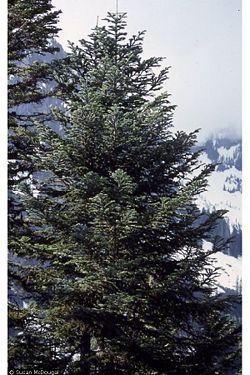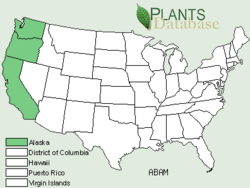Pacific silver fir
| Pacific silver fir |
|---|

|
| Scientific Classification |
| Binomial Name |
|
Abies amabilis |
The Pacific Silver Fir tree is also known as the Red Silver Fir, Silver Fir, Amabilis Fir, Cascades Fir, and the Lovely Fir. The average age of this tree in good growing condition is 400 to 500 years old. The oldest recorded age is 540 years old. The bark of the older tree has a rough surface and is flaky. The younger trees have blisters filled with resin. Some interesting facts are that these trees have edible parts and have several medicinal uses. The pitch can be used as a gum. The young needle shoots can be used for making tea. The inner bark can be dried and ground and mix with flour to make bread. Also, native America Indians used many parts for medicine. For example, the bark was used to treat stomach ailiment and various minor compliants. The pitch was used to treat colds and sore throats.[1]
Anatomy
The needles of the Pacific silver fir are flat and uniform in length. Their lengths are 1 to 1.5 inches long with stomata on the lower surface only clothe top and sides of twigs. Their cones are barrel shaped and purple in color. They are 3 to 6 inches long and have bracts shorter than scales. The color of the bark is anywhere from silvery to ash gray and is smooth and hardly ever furrowed. This tree grows anywhere from 100 to 150 feet tall and it’s 1 to 3 feet in diameter. It’s crown is dense and spire like. (Brockman, p46)
Reproduction
Pacific silver firs are self fertilized. Self fertilization is possible because the times of pollen release and seed receptivity overlap. The cones are purple in color when they are receptive to pollination. The pollen cones are red in color. There is a 6 week delay between pollination and fertilization. Pollination and fertilization varies depended upon location, altitude and soil condition. It varies anywhere from mid May to mid June. The seeds are mature in late August and are released and spread in mid September. Of all the different confers, it is one of the earliest dispersers. Most all of it’s seeds are shed by the end of October. The Silver Fir does not start cone production until after 20 to 30 years. Compared to other firs, it is not considered a good seed producer. Good seed crops cycle about every 3 years. It is one of the heaviest seed of all confers and each seed contains a single wing. They don’t require wind to disperse and usually are carried no farther than 114 meters with most landing within 38 meters of the stand. The seeds germinate in the spring after being under snow all winter. They germinate best in full sun light and in cool moist soil. The seedlings can grow in dense shade.[2]
Uses
Pacific silver fir is used in urban landscaping and grown commercially for Christmas trees. When used for landscaping, sufficient space should be allocated for the relatively large size of mature trees. The soft, light-weight wood is weak and has low durability. It has been used for light construction frames, construction plywood, container veneer, and pulpwood.
The dense growth of Pacific silver fir provides cover and protection during the winter for wildlife. Old-growth stands provide habitat for mountain goat, northern spotted owl, Vaux’s swift, western red-backed vole, and the Olympic salamander. Seeds provide food for birds, rodents, and squirrels, while the leaves of growing shoots are browsed by elk.[3]
Ecology
The area where the Pacific Silver Fir grows is the Pacific coastal mountain range of northwestern California, Oregon, Washington, western British Columbia and southeastern Alaska. It grows in a variety of habitats such as high mountain slopes, woodland, and all the way down to sea level in the north of its range. It thrives in cool wet air condition areas and in deep moist soils.[4]
Gallery
 Browse |
References
- Brockman, Frank. Trees of North America. New York: Golden Press, 1968
- Pacific Silver Fir
- The Medicine of North American Plants (must type Pacific Silver Fir in search box)
- PACIFIC SILVER FIR Plant Guide by the U.S. Department of Agriculture





